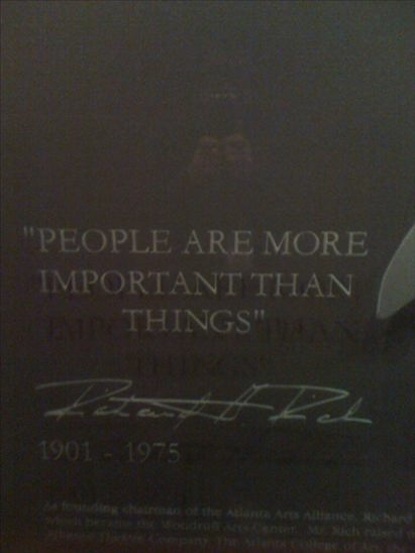One of my students found and snapped this plaque at last week’s Art History of Games symposium.

When mounted in an art museum like the High, an inscription this strives to remind its visitors that they stand above the artifacts held hostage in the galleries, despite the apparent attention paid to (and the incredible sums paid for) those artifacts.
It encapsulates an ongoing question that many ask of object-oriented ontology. These qualms are expected and reasonable; OOO and other new directions in metaphysics propose approaches that are bound to feel uncomfortable precisely because they ask us to stop situating ourselves at the center of being. Seeing the celebration of humanity reduced to a pithy one-liner and etched forever into stone only reads like caricature to me now, not like reverence.
Due to the conference last week and with preparations for the Independent Games Summit in March, I’ve fallen far behind in my usual blog reading, but Levi wrote a good one last month on the subject of “inhuman ethics” that addresses the problem of putting things and humans on the same slate, as it were, as equals rather than as slaves and masters.
do we have the fortitude to formulate the possibility of a communism of human and nonhuman beings, or will we remain in the rut of human emancipation alone, pretending that the human … is nonetheless the exclusive domain of a modernist human emancipation.
Among many points, in this post Bryant helps us see why an object-oriented approach actually becomes necessary to liberate humans in the way Modernism thought it had done. How, after all, can we pose questions of ethics or politics before having taken some record of what entities fall under, above, within, and without the purview of human action? And, as Bryant asks, what do humans become when coupled to the world in new entities?
As it stands, once reminded that it is she who is of consequence, the museum-goer can feel free to ignore all those curious objects around her: the Baga sculptures, the Renoir, the mahogany bookcase; but also the Richard Meier façade, the parking deck, the docent’s uniform, the very concept of the museum.
A new inscription then, perhaps: People, among the things.
Comments
Simon Ferrari
Woot! I was afraid you’d missed the Tweet containing this picture. You will be happy to know, related to OOO and ethics, that I’m writing a wonderful paragraph against Sicart’s ontological distinction between rules and mechanics right at this very moment.
Mark Thompson
I suppose I’m still a bit confused about this part: is OOO descriptive or prescriptive in its request that we stop situating ourselves at the center of being? I suppose the problem is the following: if we are at the center of being, then where does the obligation to leave it come from? if we are not at the center of being but can situate ourselves there, then where does the prohibition to do so come from?
Suppose I am quite happy at the center of being, why should I construct any other ontological view?
Charles
I wonder about the same sort of questions. “Inhuman Ethics” sounds great but I don’t see any direct answer to the simple question of “Why Care About Objects?”
Is it just an assumption that all OOO people share? That is to say, objects have been ignored, therefore we must pay attention to them now, becaue it is philosophically important? If we say that there’s no ontological difference between people and things, then it’s only reasonable to ask how we know that?